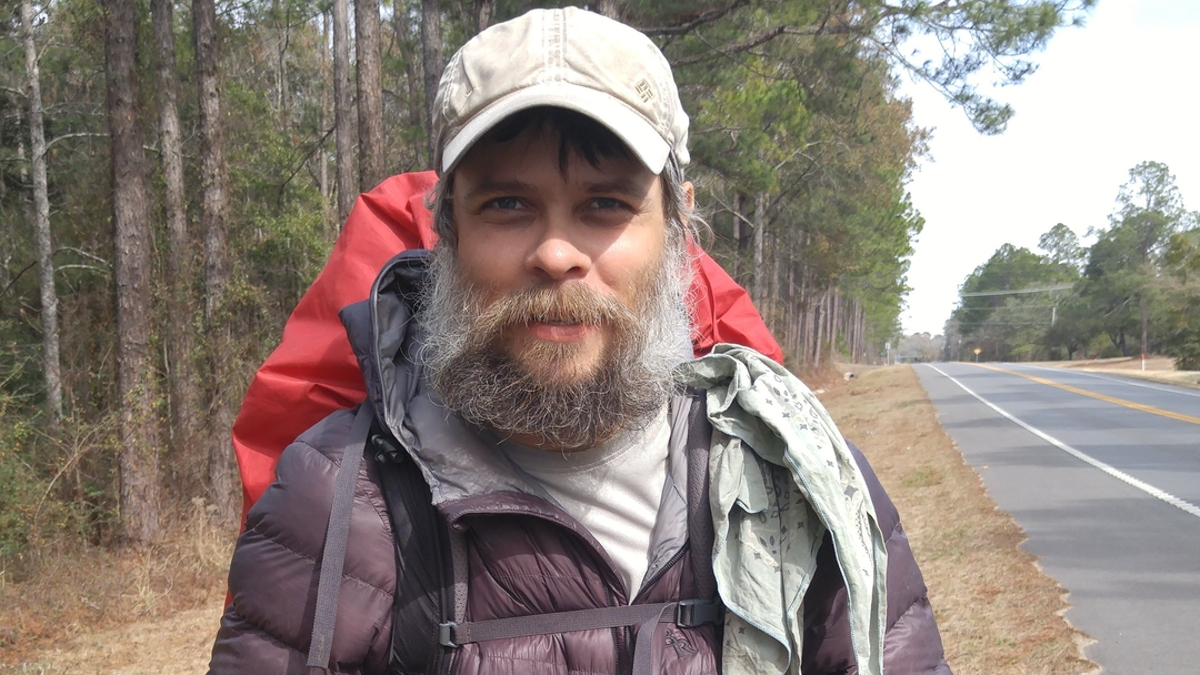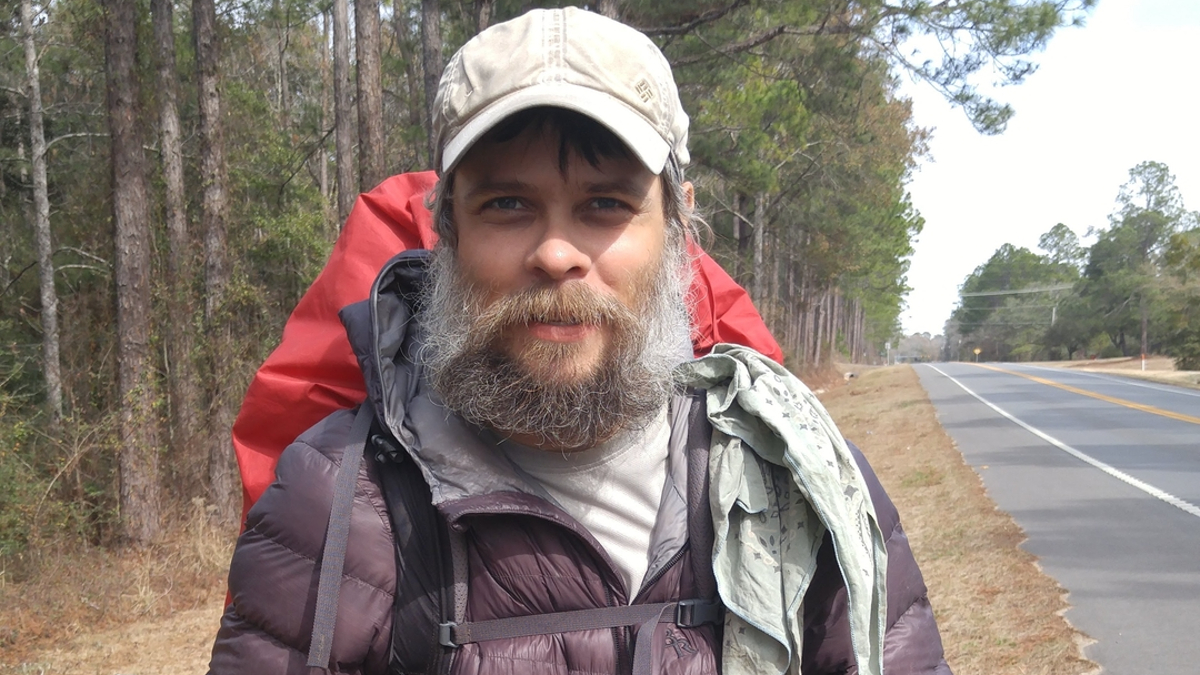In 2018, the body of a male hiker was found decomposing in a tent on the Appalachian Trail. Known by the trail name “Mostly Harmless,” police struggled to identify the hiker, inspiring journalists and a community of true crime obsessives to launch an investigation of their own. That investigation is the subject of They Called Him Mostly Harmless, a new Max documentary that is unfortunately way more preoccupied with petty drama than it is with the hiker—and the trail of victims he left behind.
Who was the Mostly Harmless hiker?
They Called Him Mostly Harmless is ostensibly about the the Mostly Harmless hiker and rehashes details laid out in a pair of Wired stories written by Nicholas Thompson, who also appears in the documentary. On July 23, 2018, two hikers in Florida found the decomposing body of a man in a tent. Upon investigating, police were not able to determine the cause of death or the man’s identity. It wasn’t long before amateur internet sleuths started Facebook groups devoted to the case, parsing out details and generating tips—some of which proved invaluable to cracking the case.
Based on Thompson’s reporting and the work of amateur sleuths, a picture began taking shape: in April 2017, the man known on the trail as “Mostly Harmless” or “Denim” (he wore jeans, the sign of an inexperienced hiker) began heading south on the Appalachian Trail from New York. Along the way, Mostly Harmless encountered other hikers, some of whom are interviewed in the documentary. The consensus seemed to be that the mysterious hiker was exactly who he said he was—mostly harmless, if a little odd. He didn’t carry the typical hiking supplies; when his body was discovered, he had a bag with a significant amount of cash, but no ID, credit cards, or cell phone. The only potentially identifying mark was a long scar on the hiker’s abdomen, leading some to speculate that he had survived a serious illness requiring surgery. That theory was quickly debunked.
That someone might want to take a hike on the AT and get off the grid, Wild-style, wasn’t necessarily unusual. The bigger question was: What led Mostly Harmless to abandon his previous life? What was he running away from?
The Facebook groups ultimately proved invaluable in cracking the case when users raised the $5,000 necessary for Othram, a company that specializes in genetic genealogy, to analyze the hiker’s DNA. The test results determined that the hiker was likely from Louisiana, and after making contact with local law enforcement and sharing the story in local Facebook groups, friends of the hiker reached out to confirm his identity: Vance John Rodriguez.
What happened to Vance Rodriguez?
Rodriguez, who also went by the online handle Vaejor, was born in 1976 outside Baton Rouge, Louisiana. Upon learning his identity, Thompson reached out to his family; he received a response from Rodriguez’s sister: “My family has no comment.” By speaking with former friends, girlfriends, and colleagues, Thompson pieced together a rough timeline of Rodriguez’s life and what led him to walk away.
According to friends, the scar on Rodriguez’s stomach was the result of a suicide attempt when he was 15. Two years later, a 17-year-old Rodriguez was legally emancipated from his family. Although he mentioned resentment toward his father, none of his friends knew exactly what led to the falling out between Rodriguez and his family.
In the years that followed, Rodriguez became a computer whiz, and even though he didn’t graduate college, he managed to become a successful coder. His former roommate Randall Godso told Wired that Rodriguez would spend 18 hours a day playing games on his computer and often suffered “huge bouts of depression.” Rodriguez wasn’t the outdoorsy type, which made his decision to hike the Appalachian Trail even more mystifying.
A friend, who asked to be identified by her middle name, Marie, helped Thompson understand Rodriguez’s life during this time:
He ate once a day, often pizza from Walmart or lasagna from Pasta Kitchen. He wore black jeans, a black shirt, and a black trench coat. He had long, dark hair almost down to his waist. One day he cut it all off and gave it to Locks of Love. He attended Dragon Con. He appeared to suffer from some mental health issues, but, according to Marie, he refused conventional medicine. “He self-medicated with drinking and chocolate,” she says. He would go on what Marie and other friends called “outages,” where he lay immobile for days, refusing food and all human contact. But eventually he would snap out of it. “He wore his sadness like an extra layer of skin,” Marie recalls. But, she adds, “I truly dug his imperfectly perfect solitary singular self.”
After speaking with former girlfriends, a darker version of Rodriguez emerged. After their break-up, a woman Rodriguez dated for five years posted on Facebook, “Apartment 950 a month / bills 300 a month / Standing up to the monster that beat you up emotionally and physically for 5 years? Priceless.” When it was revealed that Rodriguez was the Mostly Harmless hiker, the woman’s mother left a comment on the post: “This man was so abusive to my daughter, he changed her.”
Thompson spoke with another woman who dated Rodriguez, and whom he referred to as K. Rodriguez and K lived in a small apartment together in New York City, where Rodriguez continued working remotely for a time. K said that Rodriguez told her “about previous women he dated and how he treated them,” and that she stayed with him despite these “red flags.” Rodriguez was introverted and seemed lonely, but when it came to his relationship with K, he was controlling and abusive. “At one point he locked me out of our apartment after I got out of the shower without clothing because we started arguing about something I can’t even remember,” K told Thompson, adding, “That wasn’t the only time he locked me out.”
K was injured in 2016 when a terrorist set off a pipe bomb in Manhattan. Rodriguez apparently became resentful of K, who developed PTSD following the attack. “… he hated caring for me, even kept a dated log of every time I needed help,” K explained, “to the point where he left me outside in the dark—knowing that at that time I couldn’t be outside alone or be in the dark without panicking. And this is only the light stuff.”

The “Mostly Harmless” moniker originated on a Slack channel for Screeps, an online game popular among programmers, and seems to have been inspired by a book in the Hitchhiker’s Guide to the Galaxy series, written by Douglas Adams. In January 2017, Rodriguez posted to Slack, “I’m mostly harmless (for now).” Three months later, in April, Rodriguez hit the Appalachian Trail. His friends assumed he was going through another one of his “outages”—during these periods of depression, Rodriguez would lay in bed for days, refusing to eat or speak to his friends.
Although his exact cause of death remains unknown, some believe Rodriguez was having an outage when he died. As Thompson wrote:
The timeline of his last few months is unclear, but he appears to have been stuck and starving, maybe at the same campground where he was found on July 23, 2018. By the time two hikers stumbled upon his tent, his body weighed just 83 pounds. He had money, though, and he was just a few miles from a major highway. Maybe his inexperience caught up to him and he was outmatched by the bugs, the snakes, and the humidity. It’s more likely, his friends suggest, that he had one last, major outage. “I know that when he had to deal with anything, he would just lay down and sleep,” K told me. “I feel like that’s what happened. He would ignore problems and ‘sleep until it was gone.’”
While Thompson is featured throughout They Called Him Mostly Harmless, the documentary devotes little of its runtime to Rodriguez’s dark past or the women he allegedly abused. Instead of speaking with his former friends and girlfriends, director Patricia E. Gillespie devotes half of the documentary to the petty fights that broke out among a handful of amateur sleuths—all women—obsessed with solving the case.
Where They Called Him Mostly Harmless went wrong
People have been fascinated by crimes for centuries, but it wasn’t until the 20th century that we put a name to the genre: true crime. Advances in media and forensics technology have made it easier than ever to capitalize on our morbid curiosity, and there is now an entire industry built on true crime that’s grown from Dateline episodes and TV procedurals to comprise podcasts, documentaries, and entire television networks. And in the attention economy, true crime docs can no longer simply focus on the facts—the narratives need to be more sensational, more unbelievable, and more cuckoo-bananas than whatever people were talking about in their work Slack the week before.
This is one reason why documentaries about weirdo cult leaders and bizarrely un-charismatic scammers have become so popular. With a renewed wave of criticism around the ethics of true crime media, fans and casual viewers want to consume true crime stories that won’t make them feel guilty afterward. By dedicating so much time to the in-fighting among the women running these amateur sleuth Facebook groups, They Called Him Mostly Harmless validates concerns about the ethics of true crime media, turning the doc into another freak show; a window through which we can leer and mock and feel superior because, unlike these women, we have better things to do. Nevermind that these groups raised the money needed to identify Rodriguez and bring closure to the case, or that Thompson’s extensive reporting on Rodriguez’s past uncovered his alleged abuse of numerous women.
True crime media is often criticized for platforming abusers and amplifying the stories of murderers while minimizing—and sometimes ignoring—the voices of victims and survivors. Whether or not you believe there’s value in psychoanalyzing violent offenders and examining the systems that enable them, I’d like to think most of us agree that the stories of victims and survivors—the people most directly impacted by these crimes—matter far more than amateur sleuths arguing about Facebook moderation practices. In her interviews with the self-described “citizen detectives,” Gillespie occasionally approaches interesting ideas about how social media limits our understanding of other people to what is curated and shared publicly, and allows us to construct fictional, preferable versions of them in our heads.
Ultimately, Gillespie shies away from this, as well as the complexities of Rodriguez—someone whose loneliness and struggles with depression made him relatable, and whose alleged abuses of women made him a monster. Instead, They Called Him Mostly Harmless ends on a bizarre note: as the credits roll, Gillespie lingers with Christie, one of the citizen detectives, as she receives a call about another case she’s following. “They’ve got the story,” Christie cries. “Tabitha was decapitated.” It didn’t take long for Redditors to determine there was no “story” to this mid-credits scene, which feels like a twist engineered to generate water-cooler discussions. Like the amateur sleuth drama that takes up much of the documentary, this final scene is meaningless.
(featured image: Max)









